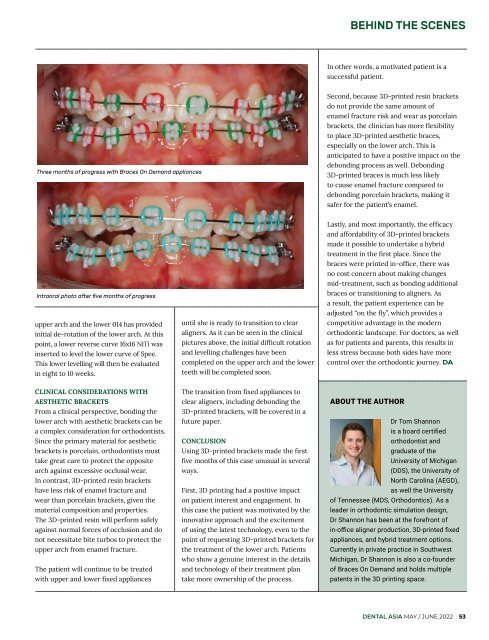Dental Asia May/June 2022
For more than two decades, Dental Asia is the premium journal in linking dental innovators and manufacturers to its rightful audience. We devote ourselves in showcasing the latest dental technology and share evidence-based clinical philosophies to serve as an educational platform to dental professionals. Our combined portfolio of print and digital media also allows us to reach a wider market and secure our position as the leading dental media in the Asia Pacific region while facilitating global interactions among our readers.
For more than two decades, Dental Asia is the premium journal in linking dental innovators and manufacturers to its rightful audience. We devote ourselves in showcasing the latest dental technology and share evidence-based clinical philosophies to serve as an educational platform to dental professionals. Our combined portfolio of print and digital media also allows us to reach a wider market and secure our position as the leading dental media in the Asia Pacific region while facilitating global interactions among our readers.
You also want an ePaper? Increase the reach of your titles
YUMPU automatically turns print PDFs into web optimized ePapers that Google loves.
BEHIND THE SCENES<br />
In other words, a motivated patient is a<br />
successful patient.<br />
Three months of progress with Braces On Demand appliances<br />
Second, because 3D-printed resin brackets<br />
do not provide the same amount of<br />
enamel fracture risk and wear as porcelain<br />
brackets, the clinician has more flexibility<br />
to place 3D-printed aesthetic braces,<br />
especially on the lower arch. This is<br />
anticipated to have a positive impact on the<br />
debonding process as well. Debonding<br />
3D-printed braces is much less likely<br />
to cause enamel fracture compared to<br />
debonding porcelain brackets, making it<br />
safer for the patient’s enamel.<br />
Intraoral photo after five months of progress<br />
upper arch and the lower 014 has provided<br />
initial de-rotation of the lower arch. At this<br />
point, a lower reverse curve 16x16 NiTi was<br />
inserted to level the lower curve of Spee.<br />
This lower levelling will then be evaluated<br />
in eight to 10 weeks.<br />
until she is ready to transition to clear<br />
aligners. As it can be seen in the clinical<br />
pictures above, the initial difficult rotation<br />
and levelling challenges have been<br />
completed on the upper arch and the lower<br />
teeth will be completed soon.<br />
Lastly, and most importantly, the efficacy<br />
and affordability of 3D-printed brackets<br />
made it possible to undertake a hybrid<br />
treatment in the first place. Since the<br />
braces were printed in-office, there was<br />
no cost concern about making changes<br />
mid-treatment, such as bonding additional<br />
braces or transitioning to aligners. As<br />
a result, the patient experience can be<br />
adjusted “on the fly”, which provides a<br />
competitive advantage in the modern<br />
orthodontic landscape. For doctors, as well<br />
as for patients and parents, this results in<br />
less stress because both sides have more<br />
control over the orthodontic journey. DA<br />
CLINICAL CONSIDERATIONS WITH<br />
AESTHETIC BRACKETS<br />
From a clinical perspective, bonding the<br />
lower arch with aesthetic brackets can be<br />
a complex consideration for orthodontists.<br />
Since the primary material for aesthetic<br />
brackets is porcelain, orthodontists must<br />
take great care to protect the opposite<br />
arch against excessive occlusal wear.<br />
In contrast, 3D-printed resin brackets<br />
have less risk of enamel fracture and<br />
wear than porcelain brackets, given the<br />
material composition and properties.<br />
The 3D-printed resin will perform safely<br />
against normal forces of occlusion and do<br />
not necessitate bite turbos to protect the<br />
upper arch from enamel fracture.<br />
The patient will continue to be treated<br />
with upper and lower fixed appliances<br />
The transition from fixed appliances to<br />
clear aligners, including debonding the<br />
3D-printed brackets, will be covered in a<br />
future paper.<br />
CONCLUSION<br />
Using 3D-printed brackets made the first<br />
five months of this case unusual in several<br />
ways.<br />
First, 3D printing had a positive impact<br />
on patient interest and engagement. In<br />
this case the patient was motivated by the<br />
innovative approach and the excitement<br />
of using the latest technology, even to the<br />
point of requesting 3D-printed brackets for<br />
the treatment of the lower arch. Patients<br />
who show a genuine interest in the details<br />
and technology of their treatment plan<br />
take more ownership of the process.<br />
ABOUT THE AUTHOR<br />
Dr Tom Shannon<br />
is a board certified<br />
orthodontist and<br />
graduate of the<br />
University of Michigan<br />
(DDS), the University of<br />
North Carolina (AEGD),<br />
as well the University<br />
of Tennessee (MDS, Orthodontics). As a<br />
leader in orthodontic simulation design,<br />
Dr Shannon has been at the forefront of<br />
in-office aligner production, 3D-printed fixed<br />
appliances, and hybrid treatment options.<br />
Currently in private practice in Southwest<br />
Michigan, Dr Shannon is also a co-founder<br />
of Braces On Demand and holds multiple<br />
patents in the 3D printing space.<br />
DENTAL ASIA MAY / JUNE <strong>2022</strong> 53


















